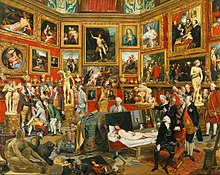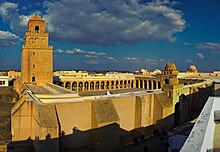Work of art: Difference between revisions
m fix XML parse, MOS italic, fix layout |
Cyberbot II (talk | contribs) Rescuing 1 sources. #IABot |
||
| Line 37: | Line 37: | ||
==Distinctions== |
==Distinctions== |
||
[[File:Duchamp Fountaine.jpg|thumb|upright|The original ''[[Fountain (Duchamp)|Fountain]]'' by [[Marcel Duchamp]], 1917, photographed by [[Alfred Stieglitz]] at his [[291 (art gallery)|291]] after the 1917 [[Society of Independent Artists]] exhibit.]] |
[[File:Duchamp Fountaine.jpg|thumb|upright|The original ''[[Fountain (Duchamp)|Fountain]]'' by [[Marcel Duchamp]], 1917, photographed by [[Alfred Stieglitz]] at his [[291 (art gallery)|291]] after the 1917 [[Society of Independent Artists]] exhibit.]] |
||
Some [[Art criticism|art theorist]]s and writers have long made a distinction between the [[physical art|physical qualities of an art object]] and its identity-status as an artwork.<ref>http://www.ftc.gov/opa/1995/08/gabos3.shtm |
Some [[Art criticism|art theorist]]s and writers have long made a distinction between the [[physical art|physical qualities of an art object]] and its identity-status as an artwork.<ref>{{cite web|url=http://www.ftc.gov/opa/1995/08/gabos3.shtm |title=Archived copy |accessdate=October 29, 2008 |deadurl=yes |archiveurl=http://web.archive.org/web/20090804100009/http://www.ftc.gov:80/opa/1995/08/gabos3.shtm |archivedate=August 4, 2009 }}</ref> For example, a painting by [[Rembrandt]] has a physical existence as an "oil painting on canvas" that is separate from its identity as a [[masterpiece]] "work of art" or the artist's ''[[magnum opus]]''.<ref>{{cite web|url=http://www.rembrandtresearchproject.org/|title=Rembrandt Research Project - Home|work=rembrandtresearchproject.org}}</ref> Many works of art are initially denied "museum quality" or artistic merit, and later become accepted and valued in museum and private collections. Works by the [[Impressionists]] and non-representational [[abstract art]]ists are examples. Some, such as the [[Readymades of Marcel Duchamp|"Readymades" of Marcel Duchamp]] including his infamous urinal ''[[Fountain (Duchamp)|Fountain]]'', are later reproduced as museum quality replicas. |
||
There is an indefinite distinction, for current or historical aesthetic items: between "[[fine art]]" objects made by "[[artist]]s"; and [[folk art]], [[handicraft|craft-work]], or "[[Applied arts|applied art]]" objects made by "first, second, or third-world" [[designer]]s, [[artisan]]s and [[Artisan|craftspeople]]. Contemporary and archeological [[Visual arts by indigenous peoples of the Americas|indigenous art]], [[industrial design]] items in limited or [[mass production]], and places created by [[environmental design]]ers and [[cultural landscape]]s, are some examples. The term has been consistently available for debate, reconsideration, and redefinition. |
There is an indefinite distinction, for current or historical aesthetic items: between "[[fine art]]" objects made by "[[artist]]s"; and [[folk art]], [[handicraft|craft-work]], or "[[Applied arts|applied art]]" objects made by "first, second, or third-world" [[designer]]s, [[artisan]]s and [[Artisan|craftspeople]]. Contemporary and archeological [[Visual arts by indigenous peoples of the Americas|indigenous art]], [[industrial design]] items in limited or [[mass production]], and places created by [[environmental design]]ers and [[cultural landscape]]s, are some examples. The term has been consistently available for debate, reconsideration, and redefinition. |
||
Revision as of 23:22, 21 April 2016
Error: no context parameter provided. Use {{other uses}} for "other uses" hatnotes. (help).



A work of art, artwork, art piece, piece of art or art object is an aesthetic physical item or artistic creation. Apart from "work of art", which may be used of any work regarded as art in its widest sense, including works from literature and music, these terms apply principally to tangible, portable forms of visual art:
- An example of fine art, such as a painting or sculpture
- An object that has been designed specifically for its aesthetic appeal, such as a piece of jewelry
- An object that has been designed for aesthetic appeal as well as functional purpose, as in interior design and much folk art
- An object created for principally or entirely functional, religious or other non-aesthetic reasons which has come to be appreciated as art (often later, and/or by cultural outsiders)
- A non-ephemeral photograph, film or visual computer program, such as a video game or computer animation
- A work of installation art or conceptual art.
Used more broadly, the term is less commonly applied to:
- A fine work of architecture or landscape design
- A production of live performance, such as theater, ballet, opera, performance art, musical concert and other performing arts, and other ephemeral, non-tangible creations.
This article is concerned with the terms and concept as used in and applied to the visual arts, although other fields such as aural-music and written word-literature have similar issues and philosophies. The term objet d'art is reserved to describe works of art that are not paintings, prints, drawings or large or medium-sized sculptures, or architecture (e.g. household goods, figurines, etc., some purely aesthetic, some also practical). The term oeuvre is used to describe the complete body of work completed by an artist throughout a career.[2]
Definition



A work of art in the visual arts is a physical two- or three- dimensional object that is professionally determined or otherwise considered to fulfill a primarily independent aesthetic function. A singular art object is often seen in the context of a larger art movement or artistic era, such as: a genre, aesthetic convention, culture, or regional-national distinction.[3] It can also be seen as an item within an artist's "body of work" or oeuvre. The term is commonly used by: museum and cultural heritage curators, the interested public, the art patron-private art collector community, and art galleries.[4]
Physical objects that document immaterial or conceptual art works, but do not conform to artistic conventions can be redefined and reclassified as art objects. Some Dada and Neo-Dada conceptual and readymade works have received later inclusion. Also, some architectural renderings and models of unbuilt projects, such as by Vitruvius, Leonardo da Vinci, Frank Lloyd Wright, and Frank Gehry, are other examples.
The products of environmental design, depending on intention and execution, can be "works of art" and include: land art, site-specific art, architecture, gardens, landscape architecture, installation art, rock art, and megalithic monuments.
Legal definitions of "work of art" are used in copyright law; see Visual arts#United States of America copyright definition of visual art.
Theories
Marcel Duchamp critiqued the idea that the work of art should be a unique product of an artist's labour, representational of their technical skill and/or artistic caprice.[citation needed] Theorists have argued that objects and people do not have a constant meaning, but their meanings are fashioned by humans in the context of their culture, as they have the ability to make things mean or signify something.[5]
Artist Michael Craig-Martin, creator of An Oak Tree, said of his work - "It's not a symbol. I have changed the physical substance of the glass of water into that of an oak tree. I didn't change its appearance. The actual oak tree is physically present, but in the form of a glass of water." [6]
Distinctions

Some art theorists and writers have long made a distinction between the physical qualities of an art object and its identity-status as an artwork.[7] For example, a painting by Rembrandt has a physical existence as an "oil painting on canvas" that is separate from its identity as a masterpiece "work of art" or the artist's magnum opus.[8] Many works of art are initially denied "museum quality" or artistic merit, and later become accepted and valued in museum and private collections. Works by the Impressionists and non-representational abstract artists are examples. Some, such as the "Readymades" of Marcel Duchamp including his infamous urinal Fountain, are later reproduced as museum quality replicas.
There is an indefinite distinction, for current or historical aesthetic items: between "fine art" objects made by "artists"; and folk art, craft-work, or "applied art" objects made by "first, second, or third-world" designers, artisans and craftspeople. Contemporary and archeological indigenous art, industrial design items in limited or mass production, and places created by environmental designers and cultural landscapes, are some examples. The term has been consistently available for debate, reconsideration, and redefinition.
See also
- Anti-art
- Artistic media
- Cultural artifact
- Outline of aesthetics
- The Work of Art in the Age of Mechanical Reproduction
- Western canon
References
- ^ John Stothoff Badeau and John Richard Hayes, The Genius of Arab civilization: source of Renaissance. Taylor & Francis. 1983. p. 104
- ^ Oeuvre Merriam Webster Dictionary , Accessed April 2011
- ^ Gell, Alfred (1998). Art and agency: an Anthropological Theory. Clarendon Press. p. 7. ISBN 0-19-828014-9. Retrieved 2011-03-11.
- ^ Macdonald, Sharon (2006). A Companion to Museum Studies. Blackwell companions in cultural studies. Wiley-Blackwell. p. 52. ISBN 1-4051-0839-8. Retrieved 2011-03-11.
- ^ Hall, S (ed.) 1997, Cultural Representations and Signifying Practice, Open University Press, London, 1997.
- ^ "There's No Need to be Afraid of the Present", The Independent, 25 Jun 2001
- ^ "Archived copy". Archived from the original on August 4, 2009. Retrieved October 29, 2008.
{{cite web}}: Unknown parameter|deadurl=ignored (|url-status=suggested) (help)CS1 maint: archived copy as title (link) - ^ "Rembrandt Research Project - Home". rembrandtresearchproject.org.
Further reading
- Richard Wollheim, Art and Its Objects, 2nd ed., 1980, Cambridge University Press, ISBN 0-521-29706-0. The classic philosophical enquiry into what a work of art is.
